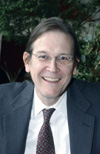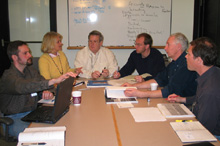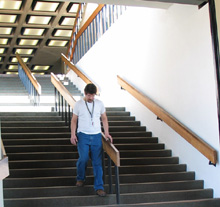 | Monday, April 5, 2004 |
|
Monday, April 5 2:30 p.m. Theoretical Astrophysics Seminar - Curia II Speaker: S. Mathur, Ohio State University Title: What is Inside a Black Hole? 3:30 p.m. DIRECTOR'S COFFEE BREAK - 2nd Flr X-Over 4:00 p.m. All Experimenters' Meeting - Curia II Special Topic: Shot Data Analysis (SDA)
Tuesday, April 6 |
|
Monday, April 5 Menu not available Eurest Dining Center Weekly Menu Chez Leon |
|
Extended Forecast |
Secon Level 3 |
| Fermilab Today is online at: http://www.fnal.gov/today/ Send comments and suggestions to today@fnal.gov Fermilab Today archive Fermilab Today classifieds Subscribe/Unsubscribe to |
Colloquium Speaker Richard Cook Examines Why Accidents Happen
In last Wednesday's Colloquium, Cook explained that a complex system has many layers of defense against accidents. Each layer contains "holes," or failures; accidents occur on the rare occasions when the holes line up. Why is human performance blamed in 85% of accidents when it is only one of the layers of defense? Cook cited hindsight bias: When an outcome is known, the pathway to that outcome seems obvious. In accidents, human performance immediately beforehand is the obvious point to criticize--but not necessarily the right one.
"I didn't give you a way to prevent accidents in this talk," Cook concluded, "but I might have given you a new way of looking at accidents after they occur."
Streaming video
of the colloquium will soon be available on the
web.
|
|
From the Kane County Chronicle, April 2, 2004 Burning season strikes prairie 'Tis the season to burn.Every year in early spring, prairie restorers wait for a nice day to light the fires that breathe new life into the landscape. "The goal is to create as much of a natural habitat as possible," said Drew Ullberg, the Kane County Forest Preserve District's director of planning.
For four to six weeks starting in the middle of March, plumes of smoke will rise from prairie projects as the forest preserve district, park districts and Fermi National Accelerator Laboratory perform the annual ritual.
|
|
Watch Your Step | ||
| ||
|
You're waiting for the elevator on the fifteenth floor of Wilson Hall. You
have coffee in one hand and a notebook in the other. That 9:00 a.m.
meeting is about to start on the eighth floor, and the elevator is taking
forever. You give up waiting and decide to run down the stairs
to save time. Crash.
Since 1982, Fermilab has had 43 recordable work injuries that in some way involved stairs. Although they accounted for only 2 percent of the total injuries, the associated losses tend to be on the high side. Eighty-eight percent of the occupational injuries occurred while employees were traveling down stairs and 72 percent were located inside a building. Slipping, mis-stepping and tripping were the main causes. Carrying something, slippery surfaces and rushing were contributing factors. Only two of the five "slippery surface" cases involved ice. The most common accident locations were Wilson Hall, DZero and buildings in the Industrial Area. The best way to prevent stair injuries is to pay attention to your path of travel, make sure you have good footing, hold onto the railing and do not rush. Regular cleaning and maintenance will also help lower the number of injuries that occur on stairs.
Have a great day and let's work safely all week!
|
|
March 31 - April 2 - During this period Operations established two stores. Those stores combined with an existing store provide the experiments with approximately 35 hours and 27 minutes of luminosity. - The Tevatron suffered a six-house quench and then a multi-house quench - Technicians continued to work on Switchyard vacuum problems
View the current accelerator update |
|
Upcoming Classes April 13 - Access 2000 Introduction April 20 - Outlook 2003 Intermediate April 27 - Outlook 2003 Advanced April 28 & 30 - Authoring Tech Reports Using MS Word May 3 - 7 Auto CAD May 11 - 13 & May 20 - 21 Java Introduction May 18 & 19 - Access 2000 Application Development June 15 & 17 - HTML Intro, Intro to Web Publishing June 21 - 25 LabView Intermediate I: Successful Devl. Prac. June 29 & July 1 - HTML Intermediate, Enhanced Layout more information |


